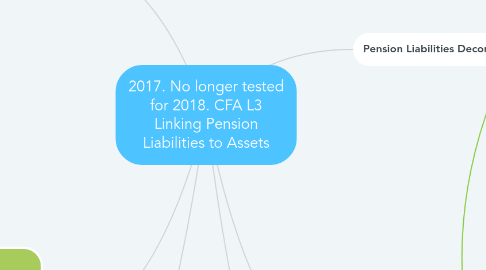
1. Linking Assets and Liabilities via Fundamental Factors
1.1. Setting Asset and Liability Sensitivities
1.1.1. Assets
1.1.2. Liabilities
1.2. Designing Investment Policies relative to Liabilities
1.2.1. This states that a Liability Mimicking portfolio may be TOO CONSERVATIVE and in order to ensure benefits get paid on future service of current employees as well as future employees that get hired, a firm with a pension will always need to make contributions to fund the liabilities.
1.2.2. Assuming Liabilities remain the same for a company that has a plan deficit, either additional company contributions or investment returns in excess of the liability mimicking returns will be necessary to correct the plan's deficit/shortfall.
1.2.2.1. These "excess" investment returns above the immunized rate will not be accomplished by using a Liability Mimicking portfolio. The only way to generate returns above the discount rate/required rate is to invest plan assets using an Asset Only approach. The burden falls upon the pension fund's investment manager to generate that required return (which is not guaranteed that they will be able to)
1.2.2.1.1. One way a Liability Mimicking Portfolio can take advantage of generating excess returns above the required rate of return is to use interest rate derivatives to hedge the market related exposures, which requires less capital than cash and thus freeing up that capital to be invested in higher returning asset classes.
1.3. Results
2. Asset Only vs. Liability Relative Approach
2.1. Asset Only (AO) approach with regards to pension plans.
2.1.1. Risk Free Benchmark
2.1.2. Characteristic of a LOW RISK investment
2.1.3. Why some pension sponsors still use AO
2.1.4. Liability Exposures
2.1.4.1. AO implicitly assumes that the liability of the pension has no risk.
2.1.5. Generally has HIGHER stock exposure. Which can result in unrewarded risks.
2.2. Liability Relative Approach with regards to pension plans (Liability Mimicking Portfolio)
2.2.1. Risk Free Benchmark used
2.2.2. Characteristic of a low risk investment
2.2.3. Liability Exposures
2.2.3.1. Focuses on exposures to factors that affect the PV of pension liabilities. (i.e. term structure, inflation, economic growth)
2.2.4. Much LOWER overall stock exposure to stocks compared to AO approach.
2.3. What is a MARKET RELATED EXPOSURE that a plans liabilities are exposed to.
3. Sample Problem for a Liability Mimicking Portfolio
4. Pension Liabilities Decomposed
4.1. Market Related Exposures
4.1.1. Inactive Participants (deferred's & retiree's)
4.1.1.1. Are benefits inflation indexed
4.1.1.1.1. Yes
4.1.1.1.2. No
4.1.2. Active Participants
4.1.2.1. Accrued Benefits
4.1.2.1.1. Same with Inactive participants. Are benefits inflation indexed? Use same appropriate underlying bonds.
4.1.2.2. Future Benefits
4.1.2.2.1. Future Wages
4.1.2.2.2. Future Service Rendered
4.1.3. Future Participants
4.2. Non Market Related Exposures (Liability Noise)
4.2.1. Inactive Participants
4.2.2. Active Participants
4.2.3. Two components of liability noise
4.2.3.1. Plan Demographics
4.2.3.1.1. Relatively more accurate to predict vs. Model Uncertainty.
4.2.3.2. Model Uncertainty
4.2.3.2.1. Different for actives vs. inactives
4.2.3.2.2. Relatively less accurate to predict vs. plan demographics.
5. How to Define Risk for a pension plan
5.1. Developing the appropriate benchmark depends on the RELEVANT INVESTMENT HORIZON for defining investment risk.
6. For the Liability Relative Approach. Use what asset to mimic what liability benefit.
6.1. Real rate bonds to mimic.....
6.1.1. active employee WAGES which is growing with inflation.
6.1.2. RETIREMENT BENEFITS which are linked to inflation
6.2. Use equities to mimic......
6.2.1. .........real wage growth is correlated with economic growth and thus equity returns.
